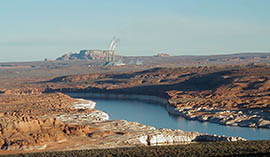- Slug: BC-CNS-Glen Canyon,465
- Sidebar: About the park.
- File photo available (thumbnail, caption below)
By BRITTANY ELENA MORRIS
Cronkite News Service
PHOENIX – The National Park Service has proposed making 17 areas of Glen Canyon National Recreation Area available for off-highway vehicle use, saying the plan would help attract a wider range of park users.
“We created a balance that meets the needs of all recreational opportunities,” said Brian Carey, a management assistant at the park, which includes 1 million acres of Arizona and Utah around Lake Powell.
It’s the preferred alternative among five in an environmental impact statement posted Jan. 15 for public comment. The alternatives range from prohibiting OHV use to making no changes.
To settle a lawsuit filed by three conservation groups, the National Park Service agreed in 2008 to develop plans to curb illegal OHV use at Glen Canyon and nine parks beyond Arizona.
The preferred alternative for Glen Canyon includes adding 15-25 mph speed limits, quiet hours, noise restrictions and new signage.
“More off-road access is being added to high-use areas, like Lone Rock Beach and its play area,” Carey said. “People have more access.”
The public has 60 days to comment on the environmental impact statement via Glen Canyon’s website.
Kristen Brengel, senior director for legislation and policy for the National Parks Conservation Association, one of the groups that sued for OHV plans, said that while her organization is drafting an official response it would prefer a more restrictive alternative for Glen Canyon.
“It’s a very remote and pristine wilderness area, and it’s the last of its kind,” she said.
OHV riders are using more than 400 roads in the area without oversight from the Park Service, Brengel said. The noise disturbs the ambiance of and scares wild animals into more remote areas where people never see them, she said.
Kim Crumbo, director of Grand Canyon National Wildlands Council, said his and other conservation groups in the region consider the preferred alternative detrimental to the environment.
“The desert is an incredibly fragile environment because it doesn’t see as much rain as other places,” he said. “If someone rips up the vegetation it takes a long time to grow back.”
John Fellmeth, president of SPEAR, a New Mexico-based off-road enthusiast group that advocates for access on public lands, said the conservation groups’ fears about the proposal are unfounded.
“If a trail is marked, motorized recreation users are responsible people and stay on the trail,” he said.
Carey noted that the proposal includes new signage to tell riders where they can and can’t go as well as social media programs to promote responsible OHV use.
“It’s important to educate the public, and I’m hopeful we figured out the difficult issues to find a good balance,” Carey said.
^___=
Glen Canyon National Recreation Area:
• Established in 1972.
• Covers 1 million acres in Arizona and Nevada.
• Includes Lake Powell, which is 168 miles long.
• Glen Canyon Dam, which created the lake, was completed in 1966.
^___=

The National Park Service has proposed allowing off-highway vehicle use in 17 areas of Glen Canyon National Recreation Area around Lake Powell, saying the plan would increase recreational opportunities.
(Arizona Department of Water Resources Photo)